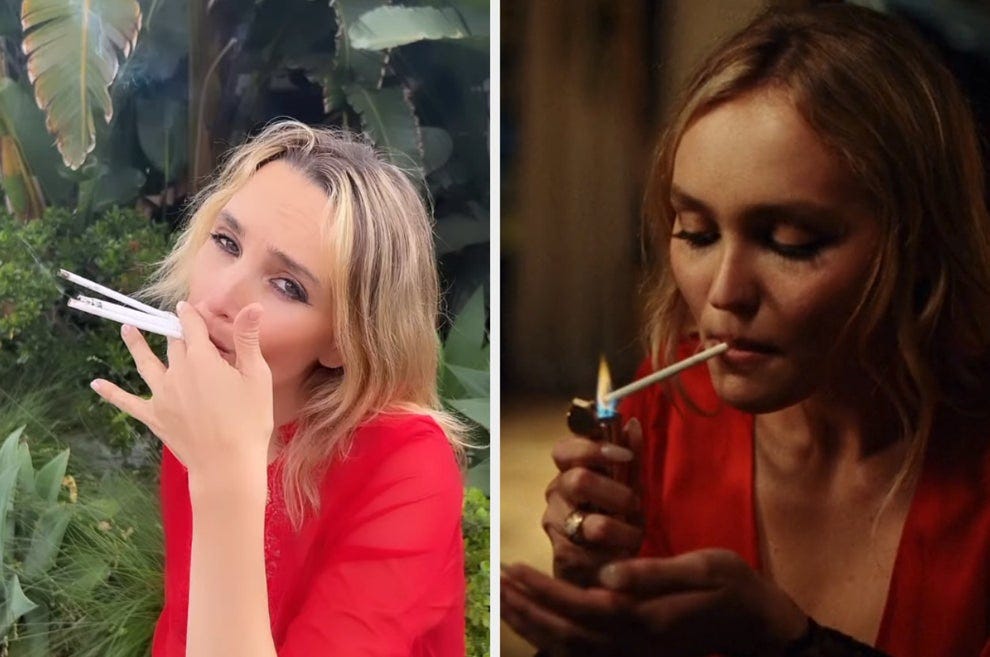If you’ve been out in London, Manchester, Brussels, Amsterdam, New York or New Orleans recently, you might have noticed something that’s been absent for a long time: the smell of cigarette smoke.
I travel a lot for work and the last twelve months, the world has felt the closest it has to a pre-pandemic world since we all shut down. But in the last few months, I’ve been noticing something even more retro than the sight of people packed into pubs or buses, I’ve noticed people – people of all ages, socioeconomics and ethnicities – smoking. Not vaping. Smoking actual lit cigarettes that smell of bygone summer festivals, school toilets, alleyways and old-fashioned cars.
This interested me, because being one of the first people to research and write about Generation Z (I started back in 2012 before anyone had even heard the expression, Gen Z), I was also one of the first people to flag their sobriety, their preference for the home rather than going out (I coined the term ‘stocialising – stay at home socialising) and their complete rejection of the demon cigs – teenage smoking remains extremely low compared to other generations and almost none of them smoked as teenagers.
However, now Gen Z are all grownup and, in their twenties, and (gasp) staring down the barrel of their thirties, even, things are beginning to change. There is a distinct shift in the Gen Z tectonic plates towards habits and lifestyles distinctly less ‘clean’ and ‘pure’ (which isn’t that surprising for people becoming grownups in stressful times), and nothing is more representative of this transformation than the slow creeping up of cigarette and cigar smoking in this generation. Incredibly the number of 18–34-year-olds who smoke rose 25% in the first pandemic lockdown and have continued to creep up ever since.
So, what’s behind all this Gen Z lighting up? Well, the first obvious one is stress. The association between the first lockdown and smoking reflects a same as it ever was reason to smoke – people tend to take up the habit in trying times – and let’s face it with cost of living, the job market, climate, the implosion of social media and political meltdown – things don’t feel any less stressful in 2025 even than when we were going through a once-in-a-lifetime pandemic – and these factors certainly hit young people the hardest.
But there are other reasons beyond stress-smoking. In the last five years, we’ve seen more sort of sexy, stylish depictions of smoking in popular culture than we have in well over a decade: think The Bear, Stranger Things, Peaky Blinders, Lily Depp in The Idol and Russian Doll. These are all films and TV wildly popular in Gen Z culture and a long way from Dot Cotton lighting up a fag in a dreary coat in Albert Square.
Moreover, it’s not just art, but the life imitating it, and lots of Gen Z icons are pretty proud smokers including Anna Taylor Joy, Lily Depp, Timothy Chalamet, Charli XCX, Jenna Ortega, Bella Hadid and Jeremy Allen White.
The weird association between smoking and sexiness has always been a thing (who doesn’t fancy a bit of emphysema?!), and it appears this is rearing its head again, with distinctly sexy Gen Z-ers, doing their generational bit to promote hot smokers.
Added to this, smoking is also having something of a moment in the manosphere with Andrew Tate, Joe Rogan and Elon Musk extolling the masculinity of cigar smoking – and indeed, what might be more masculine than a man chomping on a phallic-shaped object?
But it’s not just smoke-shows promoting smoking, but weirdly, it’s also a backlash against vaping – a thing originally designed ostensibly to get people off cigs. It’s become apparent just how bad vaping is for us, with some experts arguing it’s more addictive than cigarettes, and incredibly, lots of Gen Z see smoking as more natural, in that it uses products found in the earth – a strange logic that would make Don Draper from Mad Men very, very happy.
So how to counter this narrative that cigarettes and cigars are cool, sexy and er, natural with our rebelling Gen Z’s and possibly Gen A’s?
1.) The beauty message. When you’re young the future seems like a far-off, nebulous place and warnings over distant diseases can sometimes be ineffective. With the trend for dewy, plump and flawless skin everywhere, there’s no getting away from the fact the demon weed is the absolute antithesis of this and no amount of facials, filler and Drunk Elephant products are going to stop your face looking like an elephant’s bum if you smoke.
2.) The fitness message. Gen Z remain a generation pretty committed to looking fit and ripped. Smoking – even social smoking – inhibits every kind of fitness from lung capacity to cardiovascular capacity, and so if you light up, male or female, you’re never going to hit those fitness goals.
3.) The cost. Gen Z (except the lucky few) are a generation that are financially strapped and smoking is very, very expensive. With the caveat that lots of young people get cigarettes from black market sources – something deeply unethical as the black market for cigarettes is as nasty in people exploitation and negative social consequences as the illegal drug trade. If you buy cigarettes from legitimate sources, a pack of Marlboro Gold is going to set you back fifteen quid – just one pack a week is going to set you back £780 a year – that’s quite a lot if you’re skint.
4.) The uncool message. The association between sexy people and smoking has always been there from Bond to Bardot, James Dean to Cillian Murphy, Kate Moss to Naomi Campbell. But smoking with the wrinkled skin, black lungs and stained teeth and fingers (not to mention the smell) is distinctly not sexy, and continue on this path and even the sexiest and savviest Gen Z now will find themselves in a Dot Cotton style trenchcoat hacking up over a fag that will probably cost about seven hundred pounds come 2050 – give up now. Your future self will thank you.












Huh I didn’t realize this was happening!